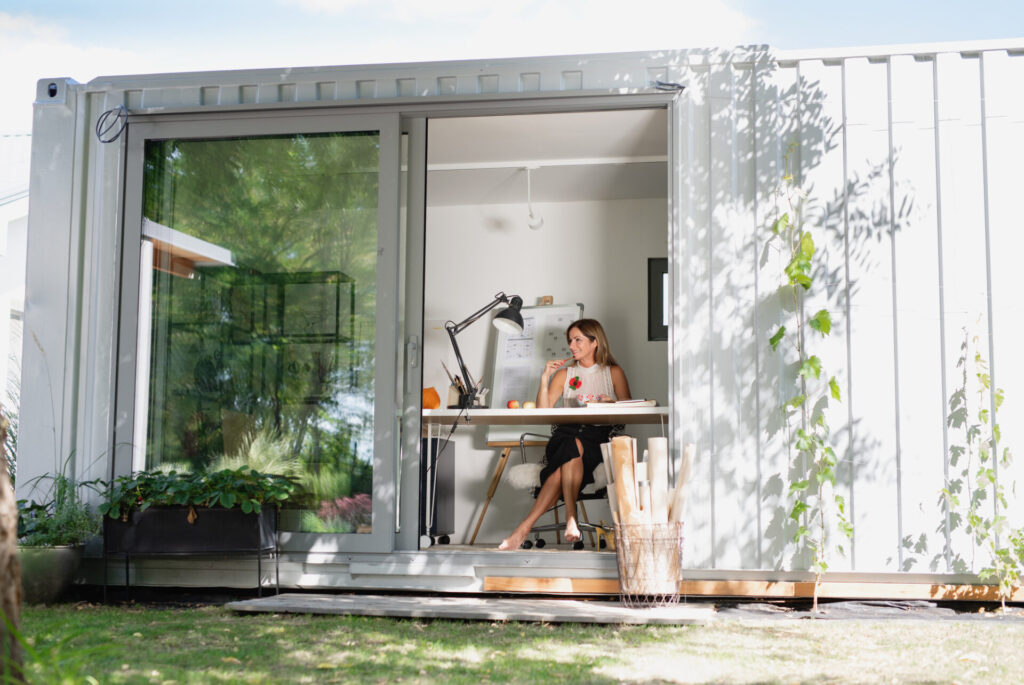The innovative use of shipping containers for sustainable, affordable living solutions has recently gained popularity. This trend highlights a growing interest in compact living spaces that balance simplicity, functionality, comfort, and style.
The container home office is a prime example of modern ingenuity and adaptability. The article offers guidance on designing a cozy and efficient container home office, capturing this innovative trend.
Step 1: Choose Your Container
Selecting the right container is the cornerstone of creating a cozy, portable shipping container office. It’s essential to choose a high-quality, weather-resistant container that ensures durability. The size of the container should align with one’s spatial needs and the intended office layout.

This phase considers factors like insulation, ventilation, and structural integrity, which are crucial for creating a comfortable and safe working environment. This stage sets the tone for the entire design process, serving as a canvas for creativity and functionality.
In the second phase of design, attention shifts to interior planning. This is where the vision for the office begins to take shape. It’s important to envision how the space will be used daily. This includes deciding on the placement of windows, doors, and interior walls.
Effective space management is key in a compact environment, and this stage allows for integrating smart storage solutions and multi-functional furniture to maximize space and efficiency.
Step 2: Create A Comfortable Environment
Effective insulation is vital in a container home office, directly impacting comfort and energy efficiency.
Using eco-friendly insulation materials can enhance the sustainability of the office while ensuring a pleasant interior climate. Proper insulation also contributes to noise reduction, which is essential for a peaceful and productive workspace.
Temperature control is another critical aspect. Installing efficient heating and cooling systems ensures that the office remains comfortable throughout the year. Options like split air conditioning units or compact heating systems can be ideal for small spaces.
Additionally, using thermal curtains or blinds can assist in maintaining a consistent temperature, further enhancing the overall comfort of the office.
Step 3: Enhance Productivity With Lighting And Ergonomics
Maximizing natural light is crucial in designing an inviting and stimulating workspace. The strategic placement of windows and skylights in a container office is transformative, flooding the space with daylight that uplifts mood and enhances productivity.
In parts of the office where natural light is not as abundant, incorporating LED lighting is an effective strategy, offering energy-efficient and comfortable illumination that keeps the workspace bright and conducive to focus.
Ergonomics plays a critical role, especially in the confined spaces of a container office. Choosing the right furniture supports healthy posture and minimizes physical strain during long hours of work. Investing in compact, ergonomic office chairs and height-adjustable desks can profoundly impact both comfort and health, making the workspace more user-friendly and conducive to long-term well-being.
Furthermore, the addition of greenery brings a touch of nature indoors, which can have a calming effect and improve air quality. This reflects personal style and creates a more welcoming atmosphere.
Step 4: Hitch Up Some Connectivity And Technology
In today’s digital age, a container home office requires reliable connectivity and modern technology.
Ensuring strong Wi-Fi signals and ample electrical outlets is essential for seamless work. Investing in quality internet solutions and using Wi-Fi extenders can help overcome the potential signal challenges posed by the container’s metal walls.
Incorporating smart technology enhances the functionality of the office. Smart lighting, thermostats, and security systems provide convenience and contribute to the space’s energy efficiency.
Integrating these technologies ensures that the portable shipping container office is not just a physical workspace but a connected hub for productivity.
Step 5: Personalize Your Space
The final touch in designing a container home office is personalization. This is where one’s style and preferences come into play.
Selecting a color scheme that reflects personal taste and creates a desired mood is vital. Using a combination of paint, textures, and art can transform the industrial feel of a container into a warm and inviting workspace.
Furniture and decor should reflect both functionality and personality. Choosing pieces that resonate with personal style while serving practical purposes makes the office not just a place of work but a reflection of one’s identity.
Whether it’s minimalist, rustic, or modern, the aesthetic choices made in this step bring the container office to life, making it a truly unique and enjoyable space.
Conclusion
Designing a cozy container home office is a journey of balancing functionality with personal style. Each step contributes to creating a compact yet comfortable workspace, from selecting the right container to personalizing the space.
Embracing the trend of container offices reflects a commitment to innovative and sustainable living and opens the door to a personalized and efficient work environment. The result is a portable, stylish, and cozy office space that meets the demands of the modern professional.

